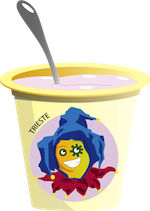Team:Trieste/project/overview
From 2012.igem.org
| Line 115: | Line 115: | ||
</br> | </br> | ||
</br> | </br> | ||
| - | <img src="https://static.igem.org/mediawiki/2012/ | + | <img src="https://static.igem.org/mediawiki/2012/9/9f/Diapositiva3b.jpg"width="680px"/> |
</br> | </br> | ||
</br> | </br> | ||
Revision as of 17:12, 22 September 2012
Project overview
More
Background
The human intestinal microflora is considered an essential “organ”
which plays an important role in human health. This complex ecosystem
is composed of approximately 500 anaerobic and aerobic bacteria species,
most of them localized in large intestine.
Many studies on animals
bred under germ-free conditions have shown that microflora has specific
functions:
- Metabolic: fermentation of non-digestible dietary residue and endogenous mucus, salvage of energy as short-chain fatty acids, production of vitamin K, absorption of ions;
- Trophic: control of epithelial cell proliferation and differentiation; development and homoeostasis of the immune system;
- Protective: protection against pathogens.
Project overview

We engineered an indigenous strain from the gut microflora in order to create a safe, controllable and versatile molecular platform, which can be used for production of a wide range of molecules. For this purpose we used the Escherichia coli strain Nissle 1917 (commercialized as Mutaflor) as the host organism for our platform. This particular strain has been used as a probiotic for decades and its beneficial effects on human health are well documented. We introduced into the strain a gene guard system based on an inducible cumate gene guard switch and we trasformed it with a particularly designed plasmid for protein expression. The gene guard system is divided in two parts:
- the killing mechanism
- the regulating pattern
The killing mechanism is placed on the same plasmid used for protein
expression. It consists of two different proteins, T4 Holin and
Cathelicidin LL-37, both toxic for prokaryotic cells. These antimicrobial
proteins are both regulated by a cumate responsive promoter (T5 promoter
Cumate Operator) placed upstream the structural genes. Holin is the
biobrick BBa_K112000 designed by group iGEM08 UC Berkeley. This protein
comes from bacteriophage T4; it is a small membrane protein which
depolarizes and permeabilizes the membrane allowing the secretion of
Cathelicidin LL-37 to the periplasm. Cathelicidin LL-37 is an antimicrobial
peptide produced by human macrophages. It has an amphypathic structure
that allows it to associate with bacterial membrane and form pores which
lead to cell lysis; its presence in the periplasm is pivotal for its
killing effect. As an alternative killing mechanism the complex T4 Holin +
Cathelicidin LL-37 can be replaced with TSE 2 toxin, a standard biobrick
BBa_K314200 designed and characterized by Group iGEM10 Washington. TSE
2 arrests the bacterial growth.
The cumate-responsive regulator CymR,
which regulates the expression of the T4 Holin and Cathelicidin LL-37,
will be introduced into the bacterial chromosome by recombination using
the UPO-Sevilla miniTn7 Biobrick together with the helper plasmid pTNS2
which codes for the Tn7 transposase. The regulator cassette consists
of a constitutive promoter (J23100) and the cymR gene, put in tandem
in order to increase the quantity of the repressor to tightly control
toxin expression.
No Cumate Expression Mode:
CymR is continuously produced. It binds the cumate responsive promoter (T5 Cumate Operator) and inhibits the expression of T4 Holin and Cathelicidin LL-37.
Bacteria live!

Cumate-Induction Kill Mode:
Cumate enters by diffusion into bacteria, binds and inactivates the
repressor. The cumate responsive promoter (T5 Cumate Operator) is
derepressed and the expression of T4 Holin and Cathelicidin LL-37
is turned on. T4 Holin interacts with the cytoplasmatic membrane,
permeabilizes it allowing the secretion of Cathelicidin LL-37 into the
periplasmic space. Cathelicidin LL-37 binds the outermembrane and forms
pores, which leads to cell lysis.
Bacteria die!

Plasmid Transfer:
-
The plasmid transfers from the E. coli Nissle into other bacteria
via horizontal transfer. The receiving bacteria do not produce
the CymR repressor, so the cumate responsiv promoter (T5 Cumate
Operator) is derepressed and the T4 Holin and Cathelicidin
LL-37 expression is activated.
Receiving bacteria die! -
E. coli Nissle looses the plasmid. It continues to produce the
CymR repressor, which does not appear to be toxic for prokaryotic
cells.
Bacteria live and is harmless!







 "
"









